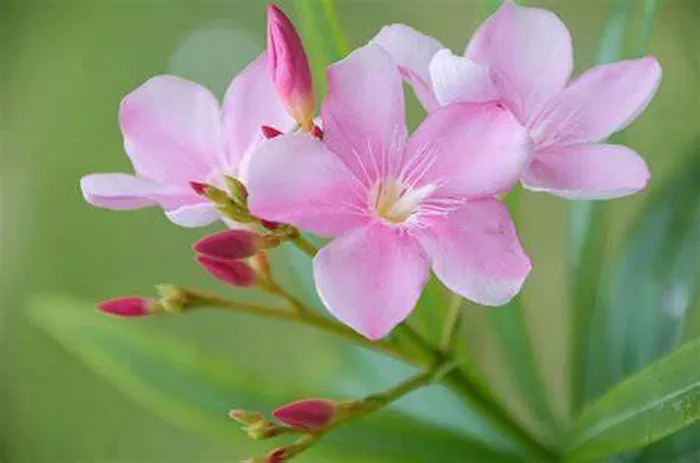Oleander flowers, with their vibrant colors and delicate blooms, are a sight to behold in gardens, parks, and landscapes around the world. This article delves into the intricate details of these flowers, exploring their appearance, characteristics, and significance in horticulture and culture.
1. Appearance
Oleander flowers, scientifically known as Nerium oleander, are renowned for their striking appearance. Here’s a detailed description of their physical characteristics:
Color: Oleander flowers come in a variety of colors, including shades of pink, white, red, and yellow. Some cultivars even feature multi-colored blooms, adding to their allure.
Shape: The flowers of oleander typically have a funnel-shaped or trumpet-like form, with five distinct petals arranged symmetrically around a central tube. These petals may be slightly ruffled or smooth, depending on the cultivar.
Size: The size of oleander flowers can vary depending on the cultivar and growing conditions. On average, the blooms measure between 1 to 3 inches (2.5 to 7.6 centimeters) in diameter.
Foliage: In addition to their blossoms, oleander plants are characterized by their long, lance-shaped leaves that are arranged in whorls along the stems. The foliage is dark green and glossy, providing an attractive backdrop to the vibrant flowers.
2. Varieties
There are numerous cultivars of oleander, each distinguished by its unique flower color, size, and growth habit. Some popular varieties include:
‘Sister Agnes’: This cultivar features large, double blooms in shades of soft pink with white accents.
‘Petite Salmon’: As the name suggests, this variety produces salmon-colored flowers that are smaller in size compared to other cultivars.
‘Hardy Red’: Known for its resilience to cold temperatures, ‘Hardy Red’ boasts bright red flowers that stand out against the plant’s dark green foliage.
‘Variegatum’: One of the variegated varieties, ‘Variegatum’ displays green leaves with creamy-white edges, adding an extra dimension to its ornamental appeal.
‘Calypso’: With its showy, double blooms in shades of deep pink, ‘Calypso’ is a favorite among gardeners looking to add a pop of color to their landscapes.
3. Fragrance
While oleander flowers are visually stunning, they are not particularly known for their fragrance. In fact, many cultivars of oleander are scentless or have a very subtle scent that is often overshadowed by other fragrant flowers in the garden. However, some individuals may detect a faint, sweet aroma, especially in the evening when the flowers release their scent most prominently.
4. Bloom Time
Oleander is known for its long blooming period, which typically extends from late spring to early fall, depending on the climate and growing conditions. In warmer regions, such as Mediterranean climates, oleander may bloom almost year-round. The peak blooming season usually occurs during the summer months when temperatures are warmest and daylight hours are longest.
5. Cultural Significance
Beyond their aesthetic appeal, oleander flowers hold cultural significance in various societies around the world:
Symbolism: In many cultures, oleander symbolizes different sentiments and emotions. While it is often associated with beauty and femininity due to its delicate blooms, oleander can also symbolize caution or warning due to its toxic properties.
Medicinal Uses: Despite its toxicity, oleander has a long history of medicinal use in traditional systems of medicine. Extracts from the plant have been used to treat a range of ailments, including heart conditions, asthma, and skin disorders. However, it’s essential to note that the ingestion of oleander can be extremely dangerous and even fatal, and its medicinal use should only be undertaken under the guidance of a qualified healthcare professional.
Cultural Practices: In some regions, oleander plays a significant role in cultural practices and rituals. For example, in parts of the Mediterranean, oleander branches are traditionally used to decorate homes during religious festivals and ceremonies.
6. Growing Tips
If you’re considering adding oleander to your garden or landscape, here are some essential growing tips to keep in mind:
1. Climate: Oleander thrives in warm, sunny climates and is well-suited to Mediterranean, subtropical, and coastal regions. It prefers full sun but can tolerate partial shade.
2. Soil: Oleander is adaptable to various soil types but prefers well-drained, slightly alkaline soil. Adding organic matter, such as compost, can improve soil structure and fertility.
3. Watering: While oleander is drought-tolerant once established, regular watering is essential, especially during periods of prolonged drought or extreme heat. However, be cautious not to overwater, as this can lead to root rot.
4. Pruning: Pruning oleander annually helps promote bushy growth and encourages abundant flowering. Remove dead or damaged branches and prune for shape and size control during the dormant season.
5. Pest and Disease Control: Oleander is relatively resistant to pests and diseases, but it may occasionally be affected by aphids, scale insects, or fungal diseases. Monitor your plants regularly and treat any issues promptly with appropriate insecticides or fungicides.
7. Safety Considerations
While oleander is prized for its beauty, it’s essential to be aware of its toxic properties and take appropriate precautions:
Poisonous: All parts of the oleander plant, including the leaves, stems, flowers, and sap, contain toxic compounds known as cardiac glycosides. Ingesting even small amounts of oleander can cause severe poisoning and, in some cases, death. Keep oleander plants out of reach of children and pets, and wear gloves when handling the plant to avoid skin irritation.
Proper Disposal: When pruning or removing oleander plants, take care to dispose of the trimmings properly. Do not burn oleander branches or leaves, as this can release toxic fumes into the air.
Medical Attention: If accidental ingestion or exposure to oleander occurs, seek immediate medical attention. Symptoms of oleander poisoning may include nausea, vomiting, abdominal pain, irregular heartbeat, and respiratory distress.
Conclusion
Oleander flowers captivate with their dazzling colors and elegant blooms, but their beauty belies their toxic nature. Whether adorning gardens, parks, or landscapes, oleander serves as a reminder of nature’s wonders and the importance of respect and caution when dealing with potentially harmful plants. By understanding and appreciating the unique characteristics of oleander, we can enjoy its beauty safely and responsibly.


